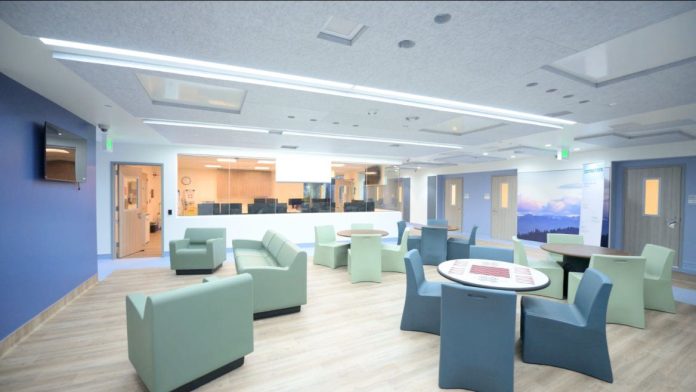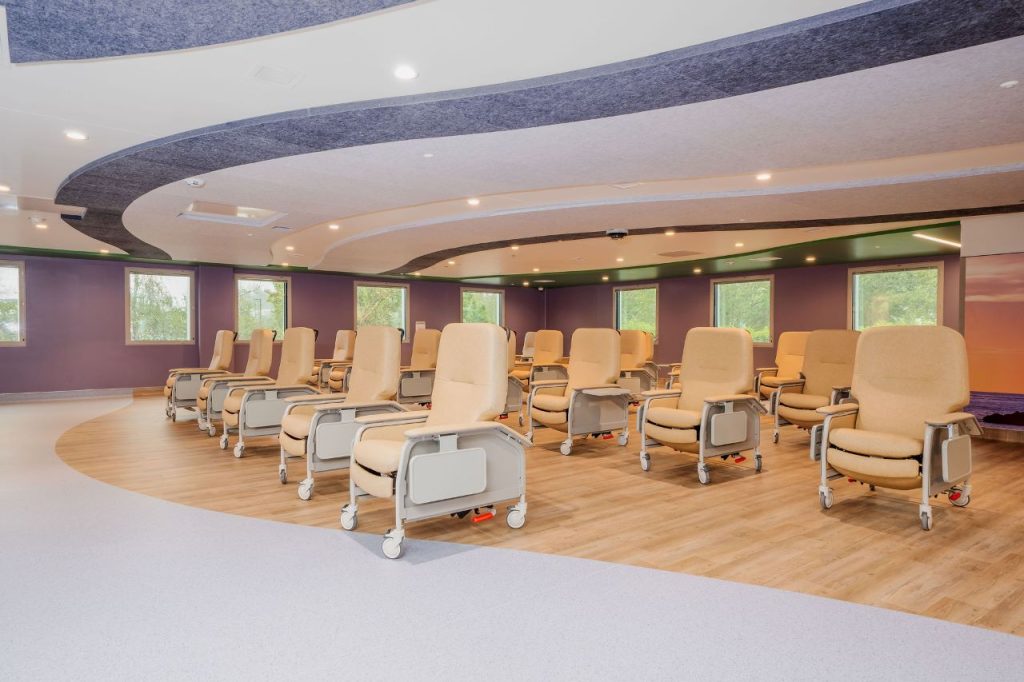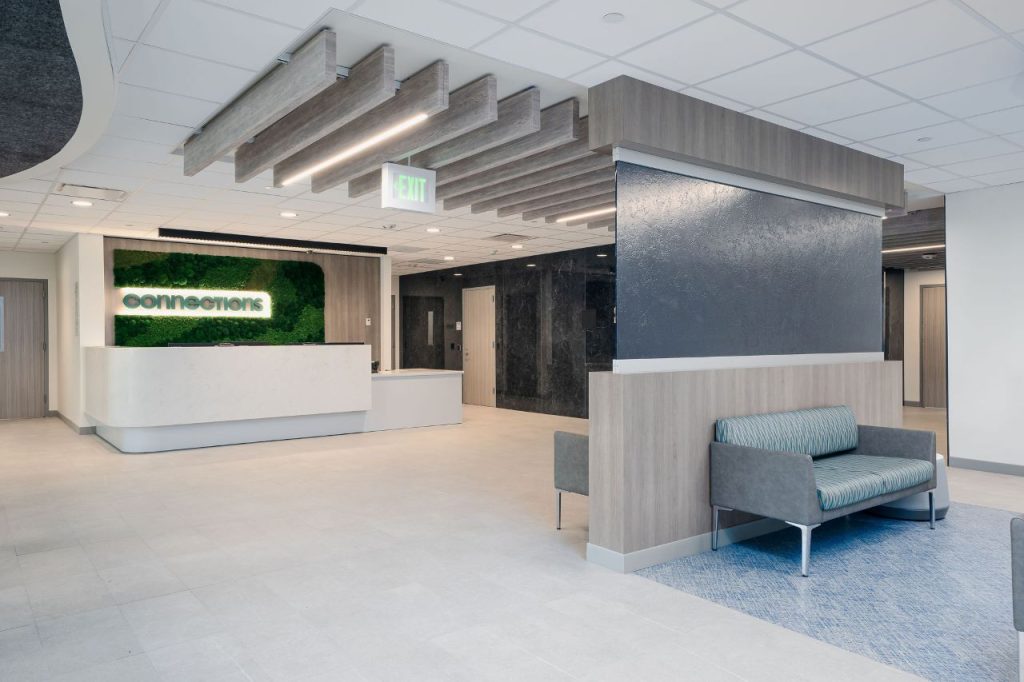
A new 24/7 walk-in mental health crisis center opened in Kirkland last summer, the first of its kind in King County. Six months later, Connections Kirkland is still trying to get the word out about the services they offer. They tout their diverse multidisciplinary team, good patient outcomes, and quick drop-off times for first responders.
“Together with the North King County community, we’re creating a new paradigm for emergency behavioral health care in Washington,” said Colin LeClair, chief executive officer for Connections Health Solutions.
Connections Kirkland has the capacity to care for up to 14,000 people per year, and the center doesn’t turn anyone away, regardless of whether they have health insurance or are a Kirkland resident. However, by the end of 2024, they’d only served 1,568 individuals, meaning they still have plenty of available capacity.
Connections Kirkland already receives 99.9% of its funding through King County. However, the center recently applied to become one of five crisis care centers throughout the county that will be paid for by the Crisis Care Centers Initiative, a $1.25 billion property tax levy, approved by King County voters in April 2023. Along with the crisis care centers, including one dedicated to youth, the levy is also supposed to pay to add residential treatment beds, provide better pay for care providers, and promote continuity of care by linking 988, mobile crisis teams, and other behavioral health resources.
The levy already paid for King County to add 10 more rapid-response mobile crisis teams last December. King County is also planning to add two more mobile crisis teams for youth early this year.
Services offered by the center
The center offers three main levels of service.
The first is their walk-in urgent care, where anyone can walk in and get a mental health appointment. Patients walking in go through a triage process and meet with a case manager to assess their needs. Then they see a psychiatric provider, who provides a full evaluation and develops a longer term treatment plan.
Patients walk in for a host of different reasons, ranging from needing to find a long-term psychiatric provider to wanting bridge scripting when they’re having trouble getting a prescription for the medication they need. Sometimes they need help getting connected to other services, like getting signed up for Medicaid. Sometimes they need help getting an outpatient appointment set up.
The average wait time right now to be seen in urgent care is under two hours. About half of patients to the center are self-referred, meaning they walk in either by themselves or with a friend or family member.
The second level of service is the center’s 23-hour observation lounge, meant as an alternative to the emergency room. It contains 32 therapeutic recliners and is designed to have continuous therapeutic engagement with its patients. The idea behind the service is that it gives people time to try different medications, potentially have drugs start to leave their systems, and process difficult feelings in a safe and supported environment.

“This is the new level of care that we have introduced to King County,” said Dr. Kyle Jasper, the center’s medical director. “I like to say the tincture of time can often really mitigate the need for hospitalization. This gives us an opportunity to try to mitigate the need for putting you in a really restrictive treatment environment.”
Compared to emergency rooms, the use of the 23-hour observation service reduces the need for inpatient hospitalization by about 50%, Jasper said. “This represents a different way we think about treating people in a psychiatric crisis,” Jasper added.
“The goal is we’re working with the patient continuously to make sure that we’re treating them in the least restrictive setting as possible,” said Joel Conger, the president of Connections West. “We share the same goal with the patient, if they’re in this facility, to get them out as quickly as we can, and [do]so in a way that’s safe and effective.”
The observation unit also has therapeutic calming rooms, and the space features photographs taken around the Puget Sound area. Patients are observed the entire time they’re present.
The last level of care offered by the center is short-term in-patient treatment for up to 14 days. On the second floor of the building, this consists of a voluntary unit and an involuntary unit, each with 16 beds. These patients receive case management and psychiatric evaluation every day, and recovery support specialists, who are peers with lived experience of mental health issues, run regular recovery groups.
Often patients need time to help finetune any medications they might be taking, as well as for their teams to help develop a long-term treatment plan, which might include finding a community treatment team or developing a housing plan.
These units also have seclusion and restraint rooms in case they’re necessary, as well as a virtual courtroom for people undergoing the process of involuntary commitment.
Other types of referrals
Connections Kirkland also has a back entrance where people can be directly dropped off by emergency medical services/fire, police departments, and alternative response teams.
Almost 20% of the center’s patients arrive via Emergency Medical Services, and almost 13% from law enforcement, represented by around 12 different police departments. Drop-offs only take around seven minutes according to statistics from both Connections Kirkland and the Kirkland Police Department.

Conger sees ready access and the low barrier to entry as a huge selling point for the center.
“We’re taking [people] from custody to care in about seven minutes. When you compare that to having to wait in an emergency room or having to put someone into jail, it’s no doubt the right solution and the right intervention,” Conger said.
He says this efficiency frees up police officers to get back out on the streets doing what they’re trained to do. Local police concur, at least based on a statement given by the Kirkland Police Department: “Hospital ER’s must triage physical injuries as well as behavioral health patients, which often significantly increases the admittance time. Connections [Kirkland] fills a crucial gap in services by providing emergency behavioral health support.”
The Kirkland Fire Department is also a proponent of the program. “The Kirkland Fire Department sees Connections as a valuable resource that bridges the gap in emergency response for behavioral health crises,” a spokesperson for the department told The Urbanist. “Connections provides a dedicated place for behavioral health support, allowing emergency rooms to be optimized for medical emergencies.”
Issues around involuntary confinement
Right now Connections Kirkland’s Evaluation and Treatment unit, where patients are involuntarily held for short periods of time, is routinely at 90% occupancy. The population of its voluntary crisis stabilization unit and observation units varies, and Conger says the center has more available capacity in those areas.
It’s not surprising that it’s taking some time for the word to get out about the 23-hour observation unit, given that it’s a level of care that is new to King County. But the high occupancy of the involuntary stabilization unit compared to usage of the center’s other services is notable.
Opponents to King County’s Crisis Care Levy back in 2023 argued that “the need to choose between locking people in jail and coercing them into treatment represents a false dichotomy” and instead advocated for more truly voluntary care and resources.
The issue of involuntary commitment has been back in the news recently, with its use being featured prominently in the City of Seattle’s much condensed 2025 state legislative priorities and the governor’s office working on a five-year strategic plan for behavioral health.
Laura Van Tosh, founder of Seattle-based Mental Health Policy Roundtable, recently had an op-ed in The Seattle Times pointing out that inpatient involuntary care can be traumatizing, lead to increased suicide risk, and is used disproportionately with racial minorities.
Instead, Van Tosh supports alternate treatment models such as crisis stabilization centers that are 100% voluntary and peer mobile engagement support.
The ACLU of Washington says involuntary commitment is also disproportionately used to treat unhoused people. They are concerned about the infringement on individual liberties represented by this practice and write that while Washington’s Involuntary Treatment Act was originally robust when it came to protections of these rights, “a series of amendments have chipped away at these rights and make it easier for individuals to be committed and harder to be released.”
Connections Kirkland doesn’t provide long-term involuntary care, although some patients do end up staying with them for longer than two weeks due to various legal vagaries.
“That’s a very tightly regulated process through the laws of Washington that we follow,” Jasper said.
Challenges in the mental health landscape
While having a new option for behavioral health care in the community is good for addressing gaps in the system, one center doesn’t address all the problems within this space.
“The medical system right now is not designed to deal really that effectively with acute psychiatric problems,” Jasper said.
Perhaps the number one problem when it comes to behavioral health treatment is a lack of housing, which creates instability as well as a greater risk of suicide.
“We’re not naive enough to think that we would fix the housing problem just by opening this facility,” Jasper said. “ We have to be realists here and know that if a patient was homeless before they came in here, there’s a likelihood that they’re going to be homeless by the time they’re ready to leave. But we do try to come up with ideas of how we can create some stability around that.”
Potential fixes include allotting beds in shelters or other short-term housing options for Connections patients, as well as using the community health care center for follow-up plans.
Jasper cited the obstacle presented by the shortage of good outpatient providers and therapists, especially those that are able to handle patients experiencing serious mental illness. Those seriously mentally ill patients could also use more wraparound services, whether that’s day treatment programs or social skills training.
He said eventually the center would like to offer a post-discharge clinic, including regular medication followup management, given wait times for outpatient providers are often long enough to cause a gap in care.
Crisis care center levy selection
The county opened a request for proposals for new crisis care center sites last fall, and Connections Kirkland submitted a proposal at that time. Contracts for sites that are launch-ready – such as Connections Kirkland– are expected to be made public in mid-February.
When asked how the center being selected as one of the official crisis care centers would impact its operations, Conger said not much would change. The center already provides detox services and has the medical capabilities to continue to do so, but they would need to receive an additional certification and make a slight adjustment to their clinical model.
“Were the opportunity to present itself for us to expand our clinical services that we provide here, that would be fantastic,” Conger said.
In the meantime, the center is continuing to work to get the word out about the services it offers.
“Our goal is to be really inclusive and meet the needs of the community,” Conger said.
Amy Sundberg is the publisher of Notes from the Emerald City, a weekly newsletter on Seattle politics and policy with a particular focus on public safety, police accountability, and the criminal legal system. She also writes science fiction, fantasy, and horror novels. She is particularly fond of Seattle’s parks, where she can often be found walking her little dog.



